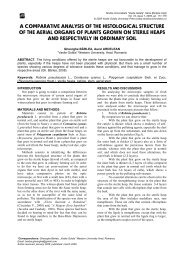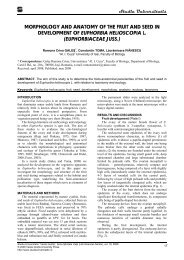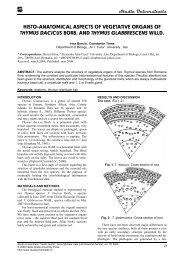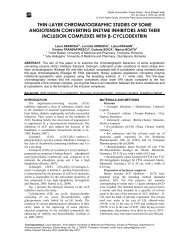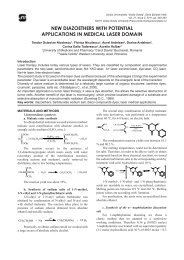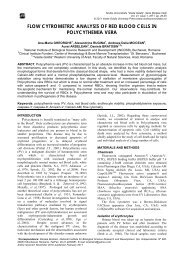the formulation and pharmacotechnical characterisation of fast ...
the formulation and pharmacotechnical characterisation of fast ...
the formulation and pharmacotechnical characterisation of fast ...
You also want an ePaper? Increase the reach of your titles
YUMPU automatically turns print PDFs into web optimized ePapers that Google loves.
Studia Universitatis “Vasile Goldiş”, Seria Ştiinţele Vieţii<br />
Vol. 23, issue 1, 2013, pp. 29-32<br />
© 2013 Vasile Goldis University Press (www.studiauniversitatis.ro)<br />
THE FORMULATION AND PHARMACOTECHNICAL<br />
CHARACTERISATION OF FAST DISPERSING TABLETS WITH<br />
ACETAMINOPHEN<br />
Mircea HÎRJĂU, Dumitru LUPULEASA<br />
University <strong>of</strong> Medicine <strong>and</strong> Pharmacy ”Carol Davila” Bucharest, Faculty <strong>of</strong> Pharmacy, Department <strong>of</strong><br />
Pharmaceutical Technology <strong>and</strong> Biopharmaceutics<br />
ABSTRACT. The present study has been carried out for <strong>the</strong> <strong>formulation</strong> <strong>and</strong> <strong>characterisation</strong> <strong>of</strong><br />
orodispersible acetaminophen tablets. This type <strong>of</strong> tablet <strong>of</strong>fers certain advantages over conventional tablets,<br />
being suitable for administration to patients with difficulties in swallowing, such as elderly <strong>and</strong> pediatric<br />
patients, <strong>the</strong>ir main characteristic – a <strong>fast</strong> disintegration in <strong>the</strong> saliva – conveying an improved compliance<br />
<strong>and</strong> improved bioavailability. Acetaminophen was selected as active pharmaceutical ingredient because it is<br />
an analgesic antipyretic drug used in <strong>the</strong> treatment <strong>of</strong> moderate pains, fever <strong>and</strong> o<strong>the</strong>r symptoms that<br />
request a rapid onset <strong>of</strong> <strong>the</strong> <strong>the</strong>rapeutic effect. The <strong>formulation</strong>s were prepared by direct compression or<br />
after wet granulation <strong>and</strong> various/different superdisintegrants were employed/ used (in <strong>the</strong> different<br />
<strong>formulation</strong>s, <strong>the</strong> aim being) to obtain tablets with suitable tensile strength/ hardness <strong>and</strong> a <strong>fast</strong><br />
disintegration. The <strong>pharmacotechnical</strong> characterization <strong>of</strong> <strong>the</strong> <strong>formulation</strong>s has revealed that <strong>the</strong> optimal<br />
formulas resulted by associating sodium starch glycolate with sodium carboxymethylcellulose,( an optimal<br />
balance between <strong>the</strong> disintegration time <strong>and</strong> <strong>the</strong> tablet hardness).<br />
Keywords: acetaminophen, direct compression, superdisintegrants, orodispersible tablets, disintregration<br />
time<br />
INTRODUCTION<br />
Oro-dispersible tablets are uncoated tablets<br />
designed to rapidly disperse in oral cavity, in less than<br />
3 minutes after administration, before being swallowed<br />
[*** Romanian Pharmacopoeia X-th edition, 2004<br />
Supplement; 2. European Pharmacopoeia, 6th edition].<br />
The origin <strong>of</strong> this type <strong>of</strong> tablet is represented by<br />
sublingual tablets. Generally, <strong>the</strong>se tablets are obtained<br />
by moistening a mix <strong>of</strong> lactose <strong>and</strong> <strong>the</strong> active substance<br />
with a mix <strong>of</strong> ethanol <strong>and</strong> water resulting a paste that is<br />
<strong>the</strong>n moulded into tablets, which are later dried <strong>and</strong><br />
packed. The most popular example <strong>of</strong> such tablets is<br />
<strong>the</strong> nitro-glycerine sublingual tablets. Also, this dosage<br />
form provides an adequate <strong>formulation</strong> for drugs which<br />
are inactivated in <strong>the</strong> gastrointestinal tract <strong>and</strong> for<br />
drugs for which <strong>the</strong> sublingual absorption minimizes<br />
<strong>the</strong> first-pass effect (Ansel et al., 1999). More recent<br />
approaches <strong>of</strong> <strong>the</strong> design <strong>of</strong> such tablets are represented<br />
by Fast Dissolving/ Dispersing Oral Tablets. This type<br />
<strong>of</strong> tablets is characterized by <strong>the</strong>ir capacity to rapidly<br />
dissolve or disperse in saliva (in 15-30 seconds) once<br />
placed on <strong>the</strong> tongue, before being swallowed. These<br />
The following substances <strong>of</strong> pharmaceutical grade<br />
were used in <strong>the</strong> <strong>formulation</strong> <strong>of</strong> <strong>the</strong> acetaminophen<br />
tablets: acetaminophen DC (Nantong Desheng<br />
Chemical Co Ltd., China), DC lactose (Tablettose 80,<br />
Meglle Pharma, Germany), microcrystalline cellulose<br />
(Vivapur 102, S&D Chemicals Ltd.),<br />
polyvinylpyrrolidone K 30 (BASF AG, Germany),<br />
sodium starch glycolate (Explotab – Ed. Mendell Co.),<br />
sodium carboxymethylcellulose (Crosscarmellose<br />
sodium – Carefarma, India), magnesium stearate<br />
(Union Derivan SA / Arnaud Romania), colloidal silica<br />
tablets are suitable for patients with swallowing<br />
difficulties, such as elderly patients <strong>and</strong> children, HIV<br />
patients or patients following radio<strong>the</strong>rapy (Dobetti,<br />
2000; Popa et al., 2003; Hirjau et al., 2009). The<br />
manufacturing technology involves tablet moulding,<br />
freeze-drying, sublimation, spray-drying, addition <strong>of</strong><br />
superdisintegrants <strong>and</strong> direct compression <strong>and</strong> <strong>the</strong> use<br />
<strong>of</strong> sugar-based excipients (Sreenivas et al., 2005).<br />
Acetaminophen is a p-aminophenol derivative with<br />
moderate analgesic <strong>and</strong> antipyretic effect. Its<br />
indications are minor to moderate pain (nerve or<br />
muscle pain, headaches, dysmenorrhea), fever <strong>of</strong><br />
various aetiology (microbial or viral infections). It is<br />
considered an antipyretic <strong>of</strong> first election for young<br />
children, in viral infections <strong>and</strong> in rheumatic pains<br />
(Cristea, 2005). The aim <strong>of</strong> this study was to obtain<br />
acetaminophen oro-dispersible tablets as an alternative<br />
to conventional oral dosage forms containing this drug<br />
(tablets <strong>and</strong> capsules), for paediatric use.<br />
MATERIALS AND METHODS<br />
dioxide (Aerosil 200, Degussa/Astron Chemicals),<br />
banana flavour, aspartame.<br />
The tablets were obtained by direct compression<br />
technique on a Triowin tableting press (Shanghai<br />
Triowin Tech. Co., Ltd., China) <strong>and</strong> a <strong>pharmacotechnical</strong><br />
characterization, consisting <strong>of</strong> <strong>the</strong><br />
determination <strong>of</strong> uniformity <strong>of</strong> mass, hardness,<br />
friability, disintegration, was carried out on all four<br />
experimental <strong>formulation</strong>s.<br />
*Correspondence: Mircea Hîrjău, „Carol Davila” University <strong>of</strong> Medicine <strong>and</strong> Pharmacy, Faculty <strong>of</strong> Pharmacy, Department <strong>of</strong><br />
Pharmaceutical Technology <strong>and</strong> Biopharmacy, Traian Vuia Str., no. 6, 020956, Bucharest, Romania, email: mirceahirjau@gmail.com<br />
Article received: December 2012; published: February 2013
Hîrjău M., Lupuleasa D.<br />
The <strong>formulation</strong> <strong>of</strong> <strong>the</strong> acetaminophen orodispersible<br />
tablets<br />
The <strong>formulation</strong> <strong>of</strong> <strong>the</strong> tablets was aimed at<br />
selecting <strong>the</strong> excipients <strong>and</strong> choosing a manufacturing<br />
technology suitable to produce rapidly dissolving /<br />
dispersing tablets with an adequate hardness. Also, <strong>the</strong><br />
aim was to mask <strong>the</strong> unpleasant taste <strong>of</strong> <strong>the</strong> drug,<br />
considering that by dispersing <strong>the</strong> tablet in saliva, <strong>the</strong><br />
taste buds come in direct contact with <strong>the</strong> tablet<br />
components for a few seconds.<br />
Four experimental tablet <strong>formulation</strong>s were taken<br />
into study. The following table shows <strong>the</strong> components<br />
for each <strong>formulation</strong> <strong>and</strong> also <strong>the</strong>ir function.<br />
Table 1<br />
The <strong>formulation</strong>s <strong>of</strong> orodispersible acetaminophen tablets<br />
Tablet components<br />
Function in<br />
<strong>formulation</strong><br />
Formula 1<br />
(g/tablet)<br />
Formula 2<br />
(g/tablet)<br />
Formula 3<br />
(g/tablet)<br />
Formula 4<br />
(g/tablet)<br />
Acetaminophen DC Active ingredient 0.1205 0.1205 0.1205 0.1205<br />
Lactose DC Filler 0.1385 0.1385 0.1735 0.1000<br />
Manitol Filler 0.0850 0.0850 0.0500 0.0500<br />
Microcrystalline cellulose Filler / Dry binder 0.1000 0.1000 0.1000 0.1735<br />
Sodium starch glycolate<br />
Superdisintegrant<br />
agent<br />
0.0250 0.0125 0.0125<br />
Sodium carboxymethylcellulose Superdisintegrant<br />
agent<br />
0.0250 0.0125 0.0125<br />
Magnesium stearate Lubricant /<br />
0.0200<br />
0.0200<br />
antiadherent<br />
0.0200 0.0200<br />
Colloidal silica dioxide Glidant 0.0100 0.0100 0.0100 0.0100<br />
Saccharin Sweetener 0.0010 0.0010 0.0010 0.0010<br />
Banana flavor Flavor q.s. q.s. q.s. q.s.<br />
Total 0.5000 0.5000 0.5000 0.5000<br />
Due to <strong>the</strong> poor compressibility properties <strong>of</strong><br />
acetaminophen, a directly compressible type was<br />
included in <strong>the</strong> tablet <strong>formulation</strong>s. Also, <strong>the</strong> filler<br />
excipients used are <strong>of</strong> directly compressible types<br />
(lactose DC <strong>and</strong> microcrystalline cellulose).<br />
Two superdisintegrating agents were used,<br />
<strong>formulation</strong>s 3 <strong>and</strong> 4 containing an association <strong>of</strong> <strong>the</strong>se<br />
two agents.<br />
Preparation <strong>of</strong> acetaminophen orodispersible tablets<br />
with acetaminophen<br />
All experimental <strong>formulation</strong>s were obtained by <strong>the</strong><br />
direct compression technique, carried out in <strong>the</strong><br />
following stages: weighing <strong>the</strong> components, dry<br />
mixing, lubricating <strong>the</strong> mix <strong>and</strong> tableting.<br />
Pharmaco-technical evaluation <strong>of</strong> <strong>the</strong> orodispersible<br />
tablets with acetaminophen<br />
In this stage <strong>of</strong> <strong>the</strong> study, <strong>the</strong> following parameters<br />
were determined, using compendial methods<br />
(European Pharmacopoeia, 6th ed., Romanian<br />
Pharmacopoeia, Xth ed.) <strong>and</strong> acceptance criteria:<br />
- appearance, color, odor, taste: organoleptic<br />
examination;<br />
- tablet thickness : Vernier caliper;<br />
- tablet diameter <strong>and</strong> hardness (VanKel VK 200<br />
Tablet Hardness Tester), on 20 tablets, according to<br />
method 2.9.5. described in Eur. Ph. 6th ed.;<br />
- friability (VanKel Friability Tester), according to<br />
method 2.9.7. described in Eur. Ph. 6th ed., on a<br />
sample <strong>of</strong> whole tablets corresponding to 6.5 g;<br />
- uniformity <strong>of</strong> mass (Sartorius pharmaceutical<br />
scale) (by determining <strong>the</strong> individual weight on 20<br />
tablets for each <strong>formulation</strong> <strong>and</strong> calculating <strong>the</strong> average<br />
weight, according to method 2.9.5. from <strong>the</strong> European<br />
Pharmacopoeia 6th ed.);<br />
- disintegration <strong>of</strong> <strong>the</strong> tablets (method 2.9.3,<br />
apparatus 1, as described in <strong>the</strong> European<br />
Pharmacopoeia, 6th ed.).<br />
RESULTS AND DISCUSSIONS<br />
Organoleptic characteristics<br />
All four experimental <strong>formulation</strong>s have resulted in<br />
plane, disc-shaped tablets, 12 mm in diameter, white in<br />
color, spotless, with no cracks <strong>and</strong> with intact margins.<br />
The taste <strong>of</strong> <strong>the</strong> tablets was sweet, producing a cool<br />
sensation after administration, due to <strong>the</strong> inclusion <strong>of</strong><br />
manitol in <strong>the</strong> <strong>formulation</strong>. Also, all <strong>the</strong> resulting<br />
tablets were odorless. The organoleptic characteristics<br />
meet <strong>the</strong> usual requirements for such tablets, described<br />
in literature.<br />
Tablet thickness <strong>and</strong> diameter<br />
Regardless <strong>the</strong> technological process applied (direct<br />
compression or compression after wet granulation), <strong>the</strong><br />
tablet thickness <strong>and</strong> diameter had similar values <strong>and</strong><br />
have shown only small variations, indicating that <strong>the</strong><br />
material that was to be compressed has good flow<br />
properties <strong>and</strong> that <strong>the</strong> compression stage was properly<br />
conducted.<br />
30<br />
Studia Universitatis “Vasile Goldiş”, Seria Ştiinţele Vieţii<br />
Vol. 23, issue 1, 2013, pp. 29-32<br />
© 2013 Vasile Goldis University Press (www.studiauniversitatis.ro)
The <strong>formulation</strong> <strong>and</strong> <strong>pharmacotechnical</strong> <strong>characterisation</strong> <strong>of</strong> <strong>fast</strong><br />
dispersing tablets with acetaminophen<br />
Fig. 1. Average thickness <strong>and</strong> diameter (mm) <strong>of</strong> <strong>the</strong><br />
experimental orodispersible tablet <strong>formulation</strong>s<br />
Fig. 2. Average weight (g) <strong>of</strong> <strong>the</strong> experimental<br />
orodispersible tablet <strong>formulation</strong>s<br />
Fig. 3. Tablet hardness <strong>of</strong> <strong>the</strong> experimental orodispersible<br />
tablet <strong>formulation</strong>s<br />
Fig. 4. Tablet friability <strong>of</strong> <strong>the</strong> experimental orodispersible<br />
tablet <strong>formulation</strong>s<br />
Uniformity <strong>of</strong> mass<br />
The results <strong>of</strong> this test are shown in figure 2.<br />
The results show that <strong>the</strong> tablets meet <strong>the</strong><br />
requirements <strong>of</strong> <strong>the</strong> Romanian Pharmacopoeia (average<br />
mass ± 5%).<br />
Tablet hardness <strong>and</strong> friability<br />
Figures 3 <strong>and</strong> 4 show <strong>the</strong> average values recorded<br />
in <strong>the</strong> determination <strong>of</strong> tablet hardness <strong>and</strong> friability.<br />
The experimental results reveal a correlation<br />
between <strong>the</strong> tablet hardness <strong>and</strong> <strong>the</strong> friability. The<br />
tablet hardness is sufficient to ensure <strong>the</strong>ir integrity<br />
during h<strong>and</strong>ling (ranged between 5.8 <strong>and</strong> 8.8 Strong<br />
Cobb units) <strong>and</strong> <strong>the</strong> friability is within accepted limits<br />
(less than 1%).<br />
Disintegration<br />
All <strong>formulation</strong>s have disintegrated rapidly, in less<br />
than 180 seconds.<br />
The results <strong>of</strong> <strong>the</strong> test are shown in figure 5.<br />
Fig. 5. The results for <strong>the</strong> disintegration test<br />
The <strong>fast</strong>est disintegration (40 seconds) could be<br />
observed for <strong>formulation</strong> 3, <strong>the</strong> disintegration stages<br />
being shown in figure 6. This <strong>formulation</strong> contains a<br />
blend <strong>of</strong> <strong>the</strong> two superdisintegrating agents, in equal<br />
parts, amounting to 5% <strong>of</strong> <strong>the</strong> tablet weight. It differs<br />
from <strong>formulation</strong> 4 by its higher content in lactose DC.<br />
Studia Universitatis “Vasile Goldiş”, Seria Ştiinţele Vieţii<br />
Vol. 23, issue 1, 2013, pp. 29-32<br />
© 2013 Vasile Goldis University Press (www.studiauniversitatis.ro)<br />
31
Hîrjău M., Lupuleasa D.<br />
Formulation 4 Formulation 3 Formulation 4 Formulation 3<br />
5 sec 5 sec 10 sec 10 sec<br />
15 sec 15 sec 20 sec 20 sec<br />
25 sec 25 sec 30 sec 30 sec<br />
58 sec 58 sec<br />
Fig. 6. The stages <strong>of</strong> disintegration <strong>of</strong> <strong>the</strong> tablets from <strong>the</strong> Formulations 3 <strong>and</strong> 4<br />
CONCLUSIONS<br />
Four orodispersible tablet <strong>formulation</strong>s containing<br />
acetaminophen were prepared by direct compression.<br />
The aim was to optimize <strong>the</strong> disintegration time by<br />
using two superdisintegration agents, included in two<br />
different concentrations (2.5% <strong>and</strong> 5%, respectively),<br />
individually (<strong>formulation</strong>s 1 <strong>and</strong> 2) or in association<br />
(<strong>formulation</strong>s 3 <strong>and</strong> 4).<br />
The resulting tablets exhibited had an acceptable<br />
hardness <strong>and</strong> disintegration time according <strong>the</strong><br />
compendial criteria. Formulation 3, containing a higher<br />
proportion <strong>of</strong> lactose DC <strong>and</strong> <strong>the</strong> blend <strong>of</strong><br />
superdisintegrants, has had <strong>the</strong> shortest disintegration<br />
time.<br />
REFERENCES<br />
Ansel H.C. , Cholas L.V., Popovich G., Pharmaceutical<br />
Dosage Forms And Drug Delivery Systems, 7th<br />
ed., ed. Lippincott Williams & Wilkins, 1999,<br />
540-541.<br />
Cristea A. N., Tratat de Farmacologie, Editia I ,<br />
Editura Medicala, Bucuresti, 2005, 199-200.<br />
Dobetti L., Fast-melting tablets: developing <strong>and</strong><br />
technologies, FarmTechEur, 2000, 12, 9, 32-42.<br />
Hirjau V., Hirjau M. in Popovici I., Lupuleasa D.,<br />
Tehnologie farmaceutică, vol. 3, ed. Polirom,<br />
2009, 645-647.<br />
Popa G., Gafiteanu E., Comprimate orodispersabile –<br />
forma farmaceutica moderna, RevMedChir,<br />
Soc. Med. Nat., Iasi, 2003, 107, 2, 337-342.<br />
Sreenivas SA, D<strong>and</strong>agi PM, Gadad AP, Godbloe AM,<br />
Hiremath SP, Mastiholimath VS. Orodispersible<br />
tablets: New-fangled drug delivery<br />
systems – A review. Indian J Pharm Educ Res,<br />
2005; 39(4): 177-181.<br />
*** Romanian Pharmacopoeia Xth edition, 2004<br />
Supplement.<br />
*** European Pharmacopoeia, 6th edition.<br />
32<br />
Studia Universitatis “Vasile Goldiş”, Seria Ştiinţele Vieţii<br />
Vol. 23, issue 1, 2013, pp. 29-32<br />
© 2013 Vasile Goldis University Press (www.studiauniversitatis.ro)



